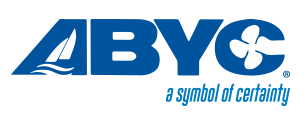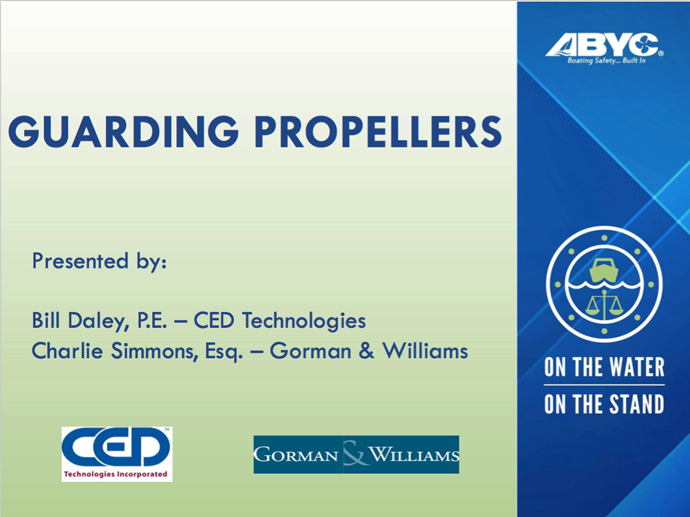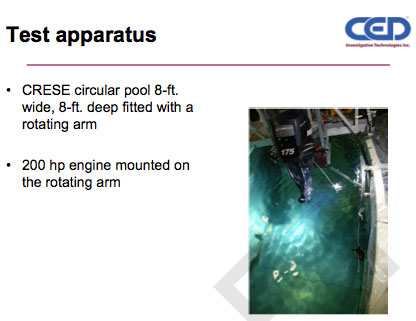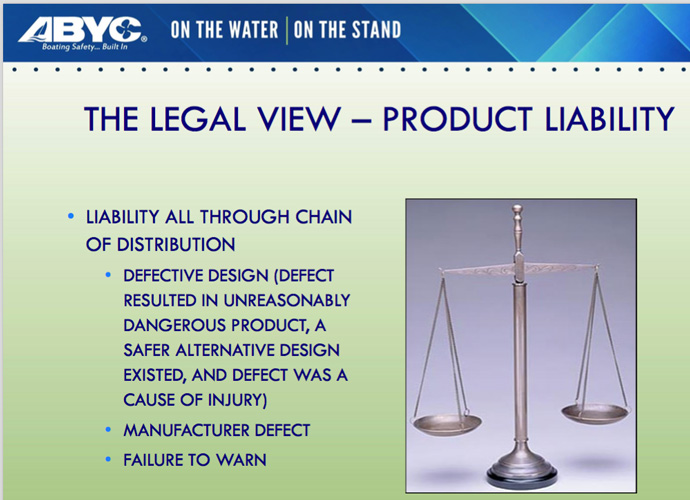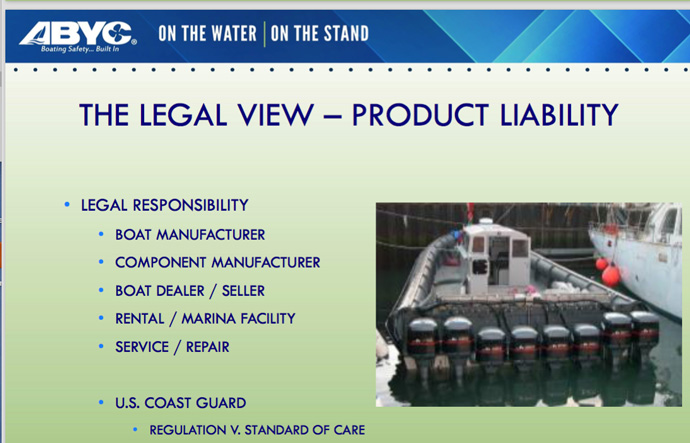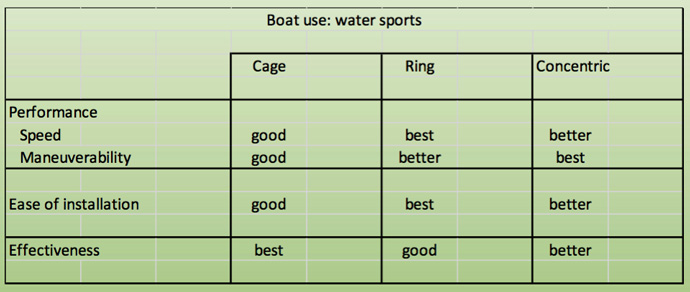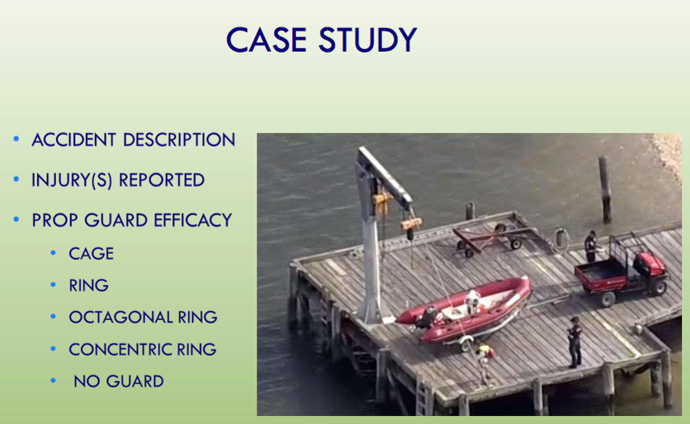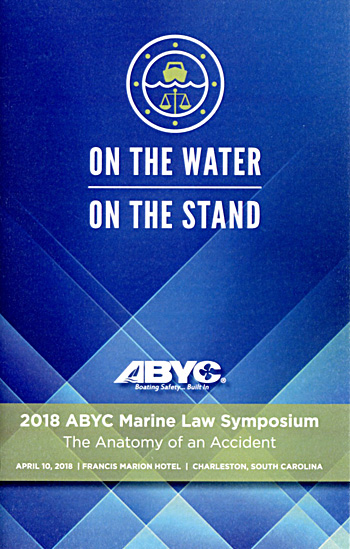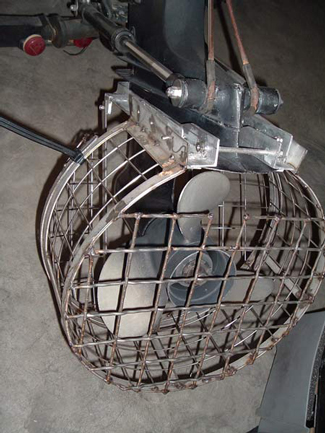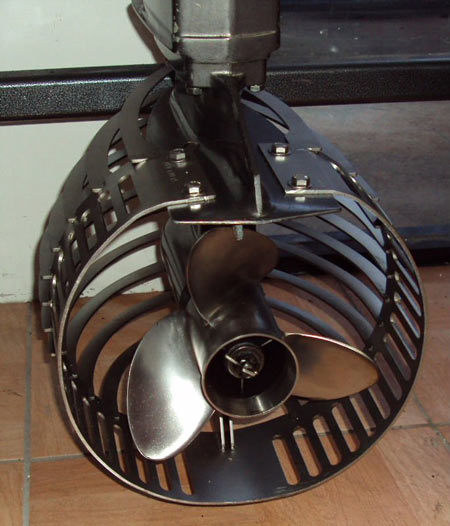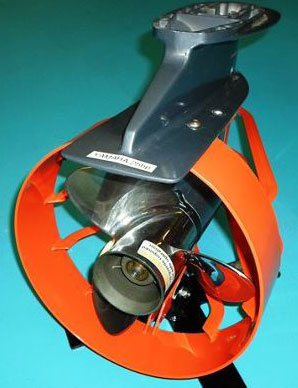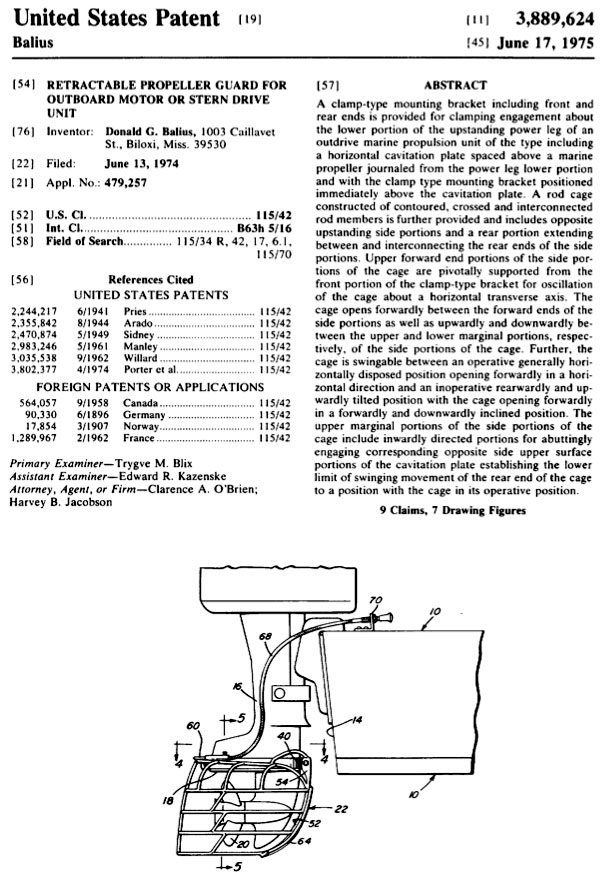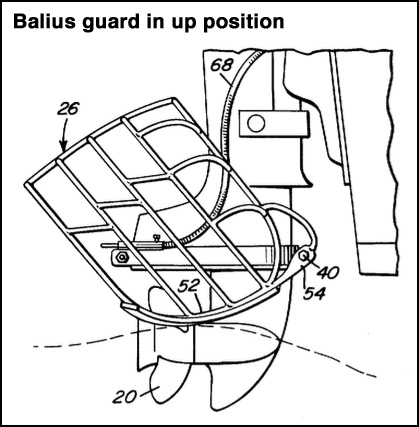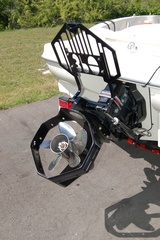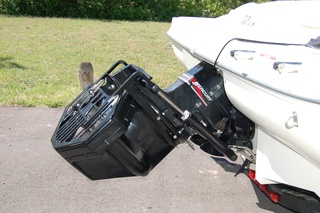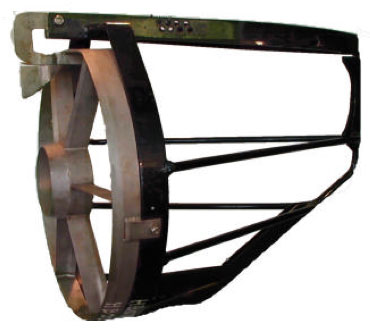Propeller Guards: ABYC Marine Law Symposium
The theme of the topics selected was, “The Anatomy of an Accident”.
The day long event featured sessions titled:
- Legal 101 (legal terms and phrases)
- Are You Covered (marine insurance with a focus on types of insurance that might be needed by a marine surveyor)
- First Responders (boat accidents from the point of view of a marine law enforcement professional, and what information might be available)
- Case Study #1 a warranty claims case
- Case Study #2 standards and record keeping issues surrounding an outboard motor falling off underway
- Case Study #3 legal and engineering principles used to limit sailboat builder’s exposure when an older sailboat capsized
- Case Study #4 The Case for Propeller Guards
- Case Study #5 case in which paths prior to a collision were established
Attendees: there were about 80 people in attendance, predominately male marine surveyors. The remainder included well known expert witnesses, legal firms mostly those associated with defending the industry, representatives of two state fish and wildlife departments, some boat builders, a few individuals from the insurance industry, a marine drive manufacturer, a component manufacturer, a manufacturer of composites, and at least one houseboat rental operation.
Among the better known names in the propeller accident field present were, Robert Taylor of DRE, Ed Fritsch and Robert Swint of ATA, William Daley of CED, and Jim Getz of Boat Accident Reconstruction Experts. Robert Taylor and William Daley were both on the program. I met Mr. Taylor and we chatted from time to time during the day. He wowed us with his interlocking fingers representation of how threads interlock for matching bolts and nuts vs. mismatched bolts and nuts during one presentation. Robert Taylor remains very smooth in explaining complex matters in legal settings and it is no wonder he was popular here.
John Adey of ABYC welcomed us to the meeting and recognized people with differing viewpoints to the industry were present. He invited everybody to join ABYC. Mr. Adey said that over time he has become more comfortable and accepting of those with opposing viewpoints to the industry as he frequently interacts with us on all kinds of matters.
Our post focuses on Case Study #4: The Case for Propeller Guards.
Our comments on the presentation are at the end of the post.
The Case for Propeller Guards
Presented by William “Bill” Daley of CED Technologies and attorney Charlie Simmons of Gorman & Williams
About the speakers (this content is paraphrased from ABYC’s materials):
William Daley – President and Senior Mechanical Engineer at CED Technologies where he played a significant role in development of the U.S. Coast Guard propeller guard test protocol. In addition to presenting, Mr. Daley was kind enough to offer a few comments on our post covering the presentation. His comments are in blockquotes.
Charlie Simmons – lawyer, partner at Gorman and Williams. Mr. Simmons also teaches Maritime Law at the University of Baltimore School of Law and is currently working on a boat propeller accident case.
William Daley began by recounting the development of the propeller guard test protocol, including testing in the large donut shaped tank at SUNY Buffalo, New York.
The slide above showing and outboard suspended in the circular tank at SUNY comes from a previous CED presentation.
Per Mr. Daley, guards representing various types of guards were tested during development of the propeller guard test protocol:
- Cage
- Ring
- Octagonal Ring
- Concentric Ring
- No Guard / Open Propeller
He said the Octagonal guard was damaged during testing and they were not able to reach a viable conclusion on it.
They impacted ballistic gel samples formed around PVC pipe at 15 mph, 5 mph, running parked, and running in reverse (meaning the samples hung vertically at certain distances off the vertical center line of the propeller as the outboard ran around the donut shaped tank. The propeller guards impacted the samples or pulled them into the propeller in some instances, see the image above).
Per Mr. Daley they entered the testing with no preconceived notions and found propeller guards could be useful in certain situations.
He noted some facts may be outliers. They looked for consistency in their data.
They found that in low speed speed applications prop guards could be effective.
Mr. Daley said high speed can be problematic for guards, they can be difficult to steer.
Guards were shown to be very effective in certain low speed applications.
Some guards made high speeds unobtainable (significantly reduced maximum speeds).
The propeller guard testing at Buffalo could be replicated by somebody with a new propeller guard.
Some people tell him the Coast Guard propeller guard protocol is too difficult to follow (too difficult to conduct). He says it is not difficult if you are a boat manufacturer.
Mr. Daley said 2009 though 2016 statistics from U.S. Coast Guard BARD (Boating Accident Report Database) data shows 13 to 15 percent of accidents involving boats are propeller strikes.
Charlie Simmons took over the presentation for a while.
Mr. Simmons said he is working on a prop strike case on the plaintiff side now.
He noted few propeller accidents become classic propeller guard legal cases and asked why. He said human error is why there are not many pure propeller guard cases. (Many of those injured contributed in some manner to the accident).
Mr. Simmons also said it is easier to sue the operator vs. the marine industry because “they fight like hell.” He said, if the industry lost a bunch of propeller guard cases it opens Pandora’s box. Product defect cases flow to everybody.
He said, most prop guarding cases fail to establish a manufacturing defect.
Mr Simmons said, Failure to Warn is often alleged but is difficult to prove because everybody knows of the obvious open danger of propellers.
The only propeller guard case to be successful recently was Brochtrup v. Mercury in the 5th Circuit. The plaintiff claimed the Mercury drive was unreasonably dangerous because it had no guard.
Someone asked about the amount of money awarded in the Brochtrup case. The presenters were not aware of the financial outcome of the Brochtrup case.
Mr. Simmons said there is an idea that if an alternative more safe design exists the industry should use it, but it may make the product more dangerous.
He said the Coast Guard was looking at regulating propeller guards in the past.
The case Mr. Simmons is currently working on involves a rental to a novice boater.
The pontoon boat was going forward, had a forward deck. The boat did 10 to 11 knots on its best day. The boat was overloaded. A young man was forward of the rail, dangling his feet in the water, he tripped into the water.
Is there an argument you should not have propeller guards? (I did not catch the answer to this question in my notes, I suspect he said something about faster vessels)
The boat in his case goes 11 knots max.
His case is not pursuing the manufacturer, there are other targets.
The industry resists in any way.
No two accidents are alike. Look at all the things and distill it.
Mr. Daley presented a matrix chart showing the effectiveness of propeller guards that was developed as part of the USCG propeller guard test protocol. (see below)
In certain regions a cage guard would prevent the accident.
Mr. Daley took back over and talked about a case study, a propeller accident at a New York Sailing Club.
Mr. Daley described the events of the accident, a boy was part of an exercise to right an overturned sailboat at a New York Yacht Club. He was picked up by a RIB, fell overboard and was stuck by the propeller (he was killed).
Mr. Daley said, a cage guard would have prevented this accident. As to who would be responsible for selecting and fitting the guard, he said he would start with the operator. Mr. Simmons said he would start with the yacht club.
Concerning the option of jet boats, Mr. Daley noted some feel traditional drives are superior to jet boats.
Then he spoke about the Safety Hierarchy (Design, Guard, Warn) and noted training can help as well. He recalled that when he was in the Navy they had 40 percent of the crew turn over every year. That made training very important.
Mr. Daley said there are two camps of thought:
- The only solution is propeller guards
- The solution is somewhere between (ABYC, lanyards, wireless lanyards, etc)
- The solution is not propeller guards
How quickly will a wireless lanyard shut down a drive and protect you? It may not prevent the 1st strike, however it will prevent the Circle of Death (the unmanned boat will not continue to run in circles repeatedly striking you with the propeller).
The time domain is important.
Lad (boy) in the water. If he had a wireless lanyard clipped to his lifejacket and the outboard did not shut down in time, would a guard still prevent the injuries?
Accidents are a combination of circumstances: people, places, and things. Know your application.
Questions and Answers session at end of presentation
Do guards have any relevance to tournament ski boats? That is a good question. (I did not catch the answer to this question in my notes)
Talking about BARD reported accidents, did they consider the severity of these accidents? BARD has a threshold of $2,000 in vessel or property damages. They did not look at the medical effects of these accidents. They could see the severity of strikes in the ballistic gel.
A question was asked about if there are some situations in which tenders should have a guard. I did not clearly hear the entire question. But I chimed in that when tenders are used with yachts and double as a lifeboat (SOLAS lifeboat) they are required to have guards by law. John Adey of ABYC said that did not apply to this smaller tender (I think he was speaking of the RIB involved in the NY yacht club accident).
I previously wrote some comments here about what Mr. Daley said about the percentage of propeller strikes that are recorded in BARD. Mr. Daley was kind enough to elaborate on his answer to us later.
Mr. Daley later explained to PropellerSafety:
As an engineer, I cannot say the number is 99%. One must speculate to understand how many accidents are not presented in BARD data. I have always said that the BARD does not represent all of the actual accidents, but does represent a database that all can use. In this sense we can then have an apples-to-apples comparison in a discussion on accidents.John Adey added to the answer by saying that the BARD represents 99% of fatalities only (all not just prop strikes) and that is a number that the USCG has used.
Did the study include data from California and Michigan (many states do not allow the Coast Guard to include their individual accident reports in Public BARD)? He thought 90 percent of the accidents were in there. Mr Daley asked, are their unique circumstances in 1 state that would change the data? The lady from Boat History Report asking the question mentioned about 24 states did not report in one year. I earlier wrote Mr. Daley’s response to this question here as it was rapidly recorded in our notes of the meeting. Mr. Daley was kind enough to elaborate on his answer to us later.
Mr. Daley later explained to PropellerSafety:
Investigating more states would not change the actual tank testing that USCG conducted.It is a different discussion when it comes to the addition of more states to the BARD. Although the BARD does not include all of the states, from a statistical standpoint, I cannot say that there would be differences in accident percentage if more states were added. From a statistical standpoint, my hypothesis would be that adding more states would not significantly change the data, but this is a hypothesis only. Again, the BARD is an accepted database. Using that database permits an apples-to-apples discussion.
Mr. Daley noted the incidence of prop strikes increases when people are already in the water (no one has to be ejected or jump off the vessel to be struck).
He mentioned the college bass tournament boat ejection video that made the rounds early last year (2017).
Someone mentioned it is hard to distinguish between the companies bringing propeller guards to market. Then someone asked if ABYC labeled propeller guards with some sort of certification? No.
Their study used off the shelf guards. They wanted them to represent a class of products (cage guards, ring guards, concentric guards, etc.).
Mr. Daley noted the concentric ring guards are mostly plastic, meaning most of them are made from plastic.
Someone mentioned they heard that some guards may not be aligned with a reputable company / manufacturer.
Mr. Simmons left quickly to catch a flight, I spoke with him briefly on his way out.
When I re-entered the room Mr. Daley was still fielding questions.
Would a marine cage work on a planing vessel?
Do you look at blunt trauma? Yes, propeller guards increase blunt trauma.
I visited with Mr. Daley after the final presentation.
Our comments on the presentation
First and foremost we congratulate William Daley and Charlie Simmons for giving a great presentation. Second, we thank ABYC for hosting the event and allowing these speakers to present materials that would have likely been censored at industry meetings just a few years ago. We appreciated Mr. Daley speaking freely about the development of the propeller guard test protocol and his strong support for the use of cage type guards in certain situations. We also appreciated Mr. Simmons speaking candidly about a case currently underway and how it fits within the framework discussed in this presentation.
Below we make specific comments about statements made during the presentation:
- Mr. Daley said the Octagonal guard was damaged during testing and they were not able to reach a viable conclusion. Mr. Daley was present at the testing and we were not. However, we have since reviewed the reports on the development of the protocol and found no mention of the Octagonal guard breaking. In addition the Octagonal guard shows in the final report dated 3 June 2013 and did complete all three sections of testing. The reports previously labeling the Round Ring Guard and Octagonal Ring Guard as separate entries. At PropellerSafety we think that with fairly similar results, they made have just decided to lump them (Round Ring Guard and Octagonal Ring Guard) together as “Ring Guard” in the matrix table used to represent guard effectiveness. In addition, Appendix C of the minutes of the 17 February 2011 USCG Accident Mitigation Meeting at the Miami Boat Show said this round of tank testing included what they called an expanded testing in response to two points raised at IBEX in September 2010. One was a larger sample size for the 3PO Octagonal Guard, the other was testing of the Australian Safety Propeller. They were still testing the Octagonal guard near the end of all testing.
- Mr. Daley said 2009 though 2016 statistics from U.S. Coast Guard BARD (Boating Accident Report Database) data shows 13 to 15 percent of accidents involving boats are propeller strikes. We are used to hearing that about 5 percent of BARD reported accidents involve propeller strikes and similarly, about 5 percent of BARD fatalities are propeller strikes. For example this quote comes from page 6 of the 2009 Human Factors Analysis of Propeller Strikes report co-authored by Mr. Daley, “Propeller strikes, including all three events, accounted for 2.9% of all boating accidents in 2007.”. Mr. Daley was likely talking about statistics for something else.
- Mr. Daley said high speed can be problematic, difficult to steer. We note the guards were tested at various trim positions including trimmed under at speed which tends to cause bow steering making many boats hard to steer.
- PropellerSafety also notes that in the real world, several people that install propeller guards switch to a different propeller with a little less pitch to allow the prop to rev back up to optimal RPM, but in the USCG propeller guard protocol test, the boats were tested with the same prop. This likely prevented some guards from reaching their best top speeds.
Mr. Daley was kind enough to elaborate on this point to us later.
Mr. Daley later explained to PropellerSafety:
To understand data collected in testing, we established control points. One of the control points was the propeller. Changing the propeller when you go to the addition of a guard changes the test and influences the results.
Perhaps additional testing could explore this better. - Mr. Daley said some people tell him the Coast Guard propeller guard protocol is too difficult to follow. He says it is not difficult if you are a boat manufacturer. At PropellerSafety, we thought the test was in part for propeller guard manufacturers to use in documenting and improving their guard, many of them lack the skills, funds, hardware, abilities to conduct the test. We know of none of them conducting the full protocol test since it was developed. But Mr. Daley is correct, major boat builders and the industry do have the skills, funds, hardware, and abilities to run the test. However, since they generally say guards do not work, they have no reason to run the test beyond defending legal cases.
- Before everybody thinks nobody ever gets struck by a propeller on a rig like the one with 8 outboards shown in one of the slides above, don’t forget the 2014 Golden Rule accident.
- The presenters were not aware of the financial outcome of the Brochtrup case. PropellerSafety comment – $3.8 million award with Brunswick 66% responsible. See our coverage of the case
- The presentation seemed to indicate Jacob Brochtrup was killed, but he lost a leg at the hip and while he almost died, he lived.
- Mr. Simmons said the only recent successful guarding case was the Brochtrup case. While that is true in terms of a guarding case tried to the end, many cases have settled. Plus many propeller injury cases go at the industry in some other manner than strictly as a propeller guarding case. For example:
- As boat design in the Bell v. MasterCraft case
- For Not requiring a kill switch to be connected before the engine is started in McGarrigle vs. Mercury Marine
- Power steering failure cases resulting in propeller injuries like Warren vs. Shelter Insurance
- Off throttle PWC steering cases from PWC’s running into propellers like Perez vs. Yamaha
- A variety of kill switch related cases
- Several cases in which outboard motors struck a submerged object, broke off, and flipped into the boat striking those on board with the propeller still rotating a few thousand RPM).
- It is interesting that Mr. Daley wrote off the octagonal guard because he says it broke during testing and there was no mention that the octagonal guard was the exemplar guard used successfully in the Brochtrup case.
- The matrix in the slide showing types of guards and their effectiveness shown above has been re-labeled as being for boats used for water sports. We suspect it was created for another presentation.
- It was shocking to hear Mr. Daley say they found that in low speed applications prop guards could be effective. Not that the findings are shocking, but that the results were being presented at an ABYC seminar. The boating industry has long said guards are bad. Mr. Daley was kind enough to comment on this point later.
Mr. Daley later explained to PropellerSafety:
I have used similar words in the past, so therefore there should be no shock. My presentations have acknowledged the usefulness of low speed applications. - Another shocker was when Mr. Daley told us wireless lanyards might not prevent the 1st strike, but they would prevent the Circle of Death (unmanned boat circling repeatedly running over you with the propeller). I never thought we would hear the phrase “Circle of Death” uttered by a speaker at an ABYC event. The boating industry strongly objects to the use of that phrase. I suspect some in the room cringed when they heard it.
- We know the New York yacht club propeller accident spoken of by Mr. Daley as the Centerport Yacht Club accident.
- Mr. Daley said, a cage guard would have prevented the yacht club accident. As to who would be responsible for selecting and fitting the guard, he said he would start with the operator. Mr. Simmons said he would start with the yacht club. At PropellerSafety we suggest the boat builder and especially the marine drive manufacturer are in a position to suggest situations when propeller guards may be needed and which guards would work best with their products in those situations. Drive manufacturers tend to have the most resources and technical expertise to make such decisions. Plus they could design their drives to accept such a guard and do so in a way they could be more quickly and easily attached. Just like drive manufacturers often prescribe certain propellers for certain models, horsepower, boat types, boat sizes, and uses, they could prescribe propeller guards for certain situations. In this particular instance (youth sailing) there are some U.S., foreign, and international boating and sailing organizations that have provided some guidance in this area as well as at least one insurance company (Gowrie Group). While in today’s environment, the yacht club is the party that needs to make the decision, the drive manufacturer and boat builder could go a long ways to ensure the yacht club has the best information before them to make the best decision for their situation.
- Mr. Daley later responded to questions regarding the percentage of propeller accidents that are recorded in BARD. He quoted John Adey and the Coast Guard as saying 99 percent of fatal propeller accidents are in BARD. We disagree that 99 percent of fatal propeller accidents are listed in BARD and are not certain USCG said it. However, we can envision USCG saying something similar to it at some time.
- A lady from Boat History Report asked the questions, did the study include data from California and Michigan (many states do not allow the Coast Guard to include their individual accident reports in Public BARD? He thought 90 percent of the accidents were in there. Mr Daley asked, are their unique circumstances in 1 state that would change the data? The lady asking the question mentioned about 24 states did not report in one year. Mr. Daley said, You could investigate 24 more states, it won’t change what happened (he was referring to their analysis of the data, not to total accident counts).
PropellerSafety comment – We followed CED’s work very closely when they were working on the propeller guard protocol. Our recollection is the Coast Guard made them a contractor and made them sign documents stating that they would not release individual accident data from the full BARD database (ALL states that reported). CED studied the full database to better understand some of the variables surrounding propeller accidents such as operator age, alcohol, engine type, operator education, operator experience, boat length, and visibility.
CED could have used the full database of Recreational Boat accidents to determine the total prop accident count, but its is much faster to just look it up in USCG’s annual Recreational Boating Statistics publication or it is even faster to look up the annual statistics in the large table on our site. - In the Question and Answers period Mr. Daley mentioned the collegiate bass fishing accident in early 2017 that was captured on video. PropellerSafety covered the accident and the resulting Public Service Announcement / PSA).
Logically extending the speakers applications for propeller guards
The speakers were strongly for the use of cage type propeller guards on slow moving pontoon boats. Mr. Daley also said age type propeller guards would have prevented the fatality of the young boy at the New York yacht club who fell from the RIB.
Together, they repeatedly said cage guards can be effective on slow moving boats.
While the speakers said nothing of rental houseboats, if they are for the use of cage type propeller guards on slow moving pontoon boats they are likely also for the use of cage type guards on slow moving rental houseboats in areas without weeds/grass in the lake or shallow water issues.
The speakers were for using a cage type guard on the propeller of the RIB in the New York yacht club accident. By extension, they would likely also be for broader use of guards on youth sailing coaching boats.
If they are for broader use of cage type propeller guards on youth sailing coaching boats, they would likely also be for using them on open water swimming escort boats, canoe race escort boats, rescue boats used for short runs, youth training boats, boats used by boy scouts, etc.
Note the speakers did NOT specifically address these applications during their presentation. We are just likening these applications to those they did say cage type propeller guards would apply.
PropellerSafety comments about the propeller guard Matrix Chart
The matrix chart used in the presentation is shown below.
We suggest the chart misleads viewers as to the ease of installation of the cage guard they tested.
The chart was meant to broadly represent types of guards, how challenging they are to install, their ability to provide protection in certain situations (effectiveness), and the challenges they may provide in the area of top speed and maneuverability.
The matrix chart represents guards as good, better, and best in each instance.
The chart shows Cage guards and being “good” in the installation category, meaning ring guards (rated “best”) and concentric guards (rated “better”) were easier to install. Mr. Daley purposefully did not mention the manufacturers of the various guards by name, but they are very obvious to those familiar with guards. Keith Jackson’s MariTech SwimGuard was the cage type guard used along with the other guards to develop the USCG propeller guard test protocol. Swimguard’s installation manual shows how easy it is to install this guard. Installation only requires hand tools, not holes need to be drilled, and the drive can be installed with the vessel in the water (important feature for houseboats).The 3 slides below come from a 2007 presentation on the status of developing the protocol to test propeller guards. The slides appear in the 2007 Propeller Guard Mitigation meeting minutes from IBEX. They are in part B of the minutes.
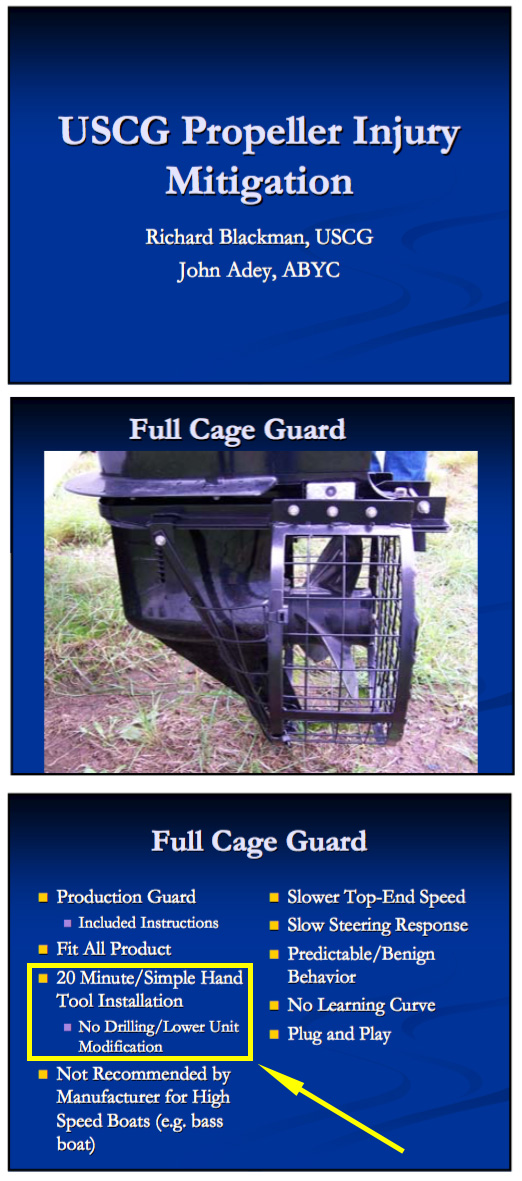
Cage Guard in USCG/ABYC presentation on status of protocol being developed for testing propeller guards. Presented at IBEX in 2007.
The slides above show the Swim Guard being installed in 20 minutes with hand tools, no drilling, and no modifications of the lower unit. The Swim Guard installs using a “harness” that wraps around the drive above the anti-cavitation plate. We suggest the Swim Guard is the easiest and fastest guard to install on the market today designed for protecting people.
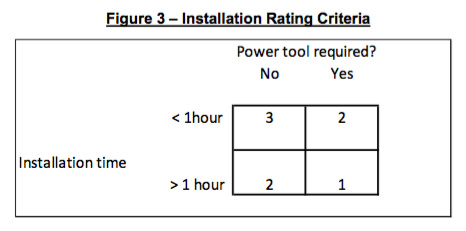
USCG Propeller Guard Test Procedure installation rating criteria chart from page 12. ABYC 3 June 2013.
The protocol itself says that if a guard installs in less than an hour with hand tools it is to be rated “3” which is equivalent of “best” (see chart above).
We grant there are other cage guards out there that require drilling and are slower to install, however the Swim Guard is the one they tested. We remain puzzled at why it received the worst rating for ease of installation, especially when it was praised for ease of installation by those at the protocol on water test site.
We note some types of guards are missing from the matrix chart
We know the matrix chart was made from guards available at that time from manufacturers willing to supply them for testing (cage, ring, concentric). We just encourage the industry to not forget that other types of guards exist in addition to those listed in the matrix chart.
Some types of propeller guards popular in other parts of the world are missing from the matrix chart, as well as some guards no longer manufactured, and some combinations of features of guards not currently on the market.
Mr. Daley commented to us on this point later.
Mr. Daley later explained to PropellerSafety:
We did not pursue those willing to provide guards. We purchased off-the-shelf guards that were available to the general public.
-
For example, vane type guards with flattened vanes running along side the propeller are popular in surf life saving applications in Australia, and Jiaxing makes them in China.
Flattened, elliptical shaped vanes present less forward facing area that rods of the same strength and reduce drag.
Yamaha sold vane type guards in the U.K., and are now they are available in Europe as the Prop Deflector.
- In the 1970s Donald Balius of Biloxi Mississippi developed several versions of propeller guards including a cage type guard that automatically swung up on skis when underway to reduce drag at speed (see image in patent above and image at left). Such a design could reduce some of the objections currently levied at cage type guards and increase their operational speeds while still providing protection at rest and in reverse. The Balius guard included a means to lock the guard down if you wished. That feature could be useful in crowded waters, at special events, and for certain activities.
- 3PO’s Navigator guard (the octagonal guard tested during the protocol) in combination with its flip up rear flap (see images above). The rear flap (they call it a shield) swings up when underway to reduce drag.
- We suggest a design combining the swing up rear flap feature currently associated with the 3PO guard as seen above could be integrated with a vane type guard (as seen at left) to provide protection to those behind the guard when the boat is at rest or backing up with minimal impact on top speeds. For example, imagine the propeller guard with a rear flap that automatically swings up when underway.
- Robert Hooper’s Prop Buddy guard with or without the Thruster on the back of it. Mr. Hooper, is now deceased and his guard is no longer on the market. PropBuddy was quick and easy to install and provided less drag at speed than most other propeller guards.
The five types of guards described above would be nice to have in your quill when prescribing guards for certain applications. Only one of them, vane type guards, can currently be relatively quickly purchased but they must come from Asia, Australia, or Europe.
We offer some additional thoughts about the design of propeller guards in our post titled Propeller Guard Design Trade Offs and in our Shock Mounted, Forward Facing, Catchers Mask Propeller Guard Invention post.
In Closing
Thanks again to William Daley of CED Technologies and attorney Chris Simmons of Gorman and Williams for making this great presentation and thanks to ABYC for sponsoring the event.
A special thanks to Mr. Daley for offering some corrections and comments on our story after we posted it. We really appreciate his time and comments in helping us get it right.
Comments
As always we invite your comments below.
